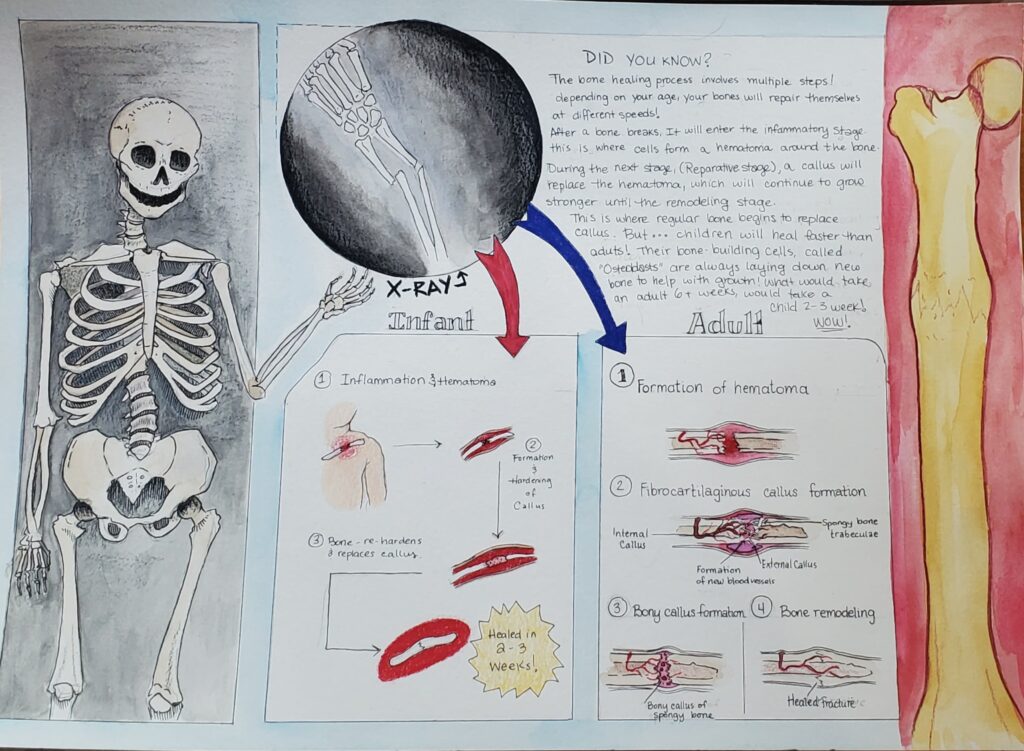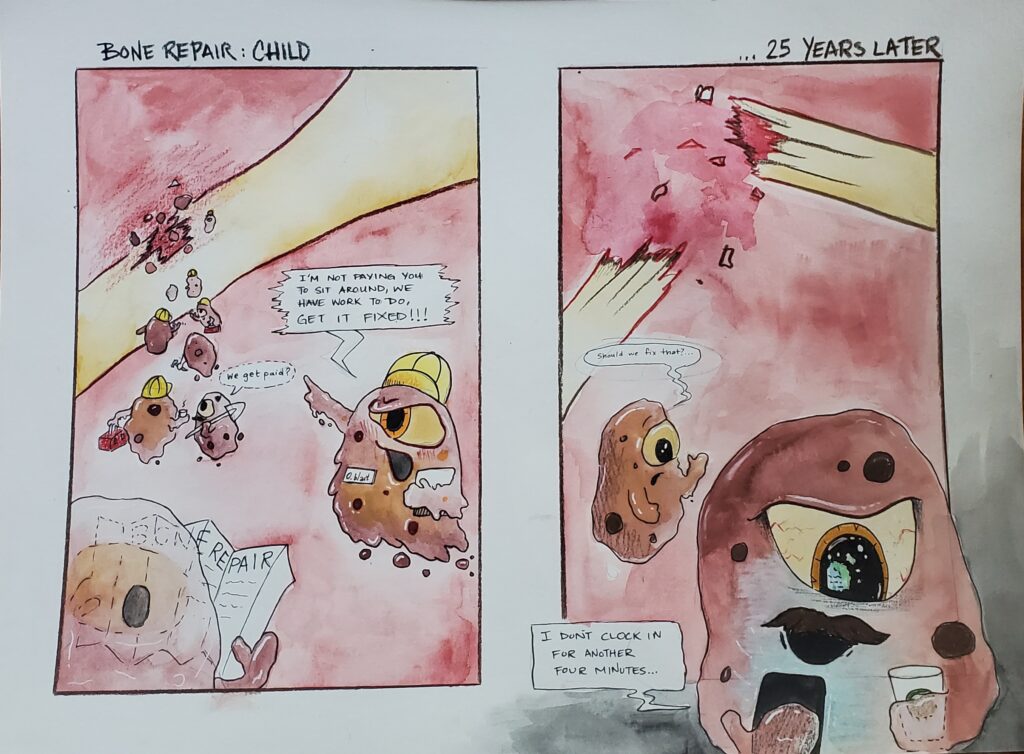

Bone Repair, Healing and processes involved; Children vs. Adults.
For my steam project, I decided to research the healing process of bone, in children versus adults. When I was growing up, my mom would always tell me, “you’re young, you will heal fast” whenever I got hurt. I never really understood why. I wanted to learn why kids healed so much faster than adults, and what mechanisms were behind their rapid healing abilities. So we will take a deeper look into differences between children and adults when it comes to how their bones are repaired, and the reasons for why it takes different amounts of time.
First things first, we all understand that children are like rubber. They are not actually made of rubber, but they are made to bounce back after an injury that in an adult would cause fracture or broken bone. Kid’s bones are thicker, and far stronger. This is in part due to “a child’s bones containing far more periosteum, which is a dense layer of connective tissue covering the bones.” (How fractures in kids are different from fractures in adults, toc.md) Because of the periosteum, the bones are far more oxygen rich, which aids in the rapid healing process.
Children go through the same healing processes that adults do when they break a bone. There are commonly known to be three stages of bone repair, these are inflammation, reparation and remodeling. The inflammation stage starts off the process of healing, this is where blood collects around the site of the break, and forms a hematoma, or a blood clot which is the bodies’ initial reaction to a broken bone. During the onset of the second stage which is reparation, a callus begins to form in the area of the hematoma. This is where children excel in bone healing. Childrens bones need less stability, and less formation of a callus is required to heal a fracture or break. “The greater subperiosteal hematoma and the stronger periosteum all contribute to a more rapid formation of a callous strong enough to render a fracture healed more rapidly than an adult.” (L.M. Lindman) This means that children not only heal faster, but they also need less “Bandaging” or callus and stability in order to heal.
A huge difference between children and adults, is that children are always growing. This means that children have constantly active, and hard working osteoblasts. “Osteoblasts are the bone- forming cells derived from pluripotent mesenchymal stem cells that can also differentiate into muscle, adipocytes, cartilage or fibrous tissues.” (M.A. Levine) During childhood development, the bones are constantly undergoing “modeling”, meaning the skeleton of a child is constantly changing, growing, breaking down, and remaking itself in order to allow the child to grow. And although the skeleton goes through this modeling process through the entirety of our lives, the process is greatly reduced as a child enters adulthood, approximately 15% of the skeleton is replaced each year in order to maintain mineral homeostasis (M.A. Levine). Children have the advantage with their constantly changing skeleton, allowing them to heal and sometimes even avoid long-term effects from bone breakage.
What does this mean for adults? Unfortunately this means that we need to be a little more careful, because our skeletons can heal, but not as efficiently as a child’s. What would take a child three to four weeks, would commonly take an adult 6 plus weeks of healing. “The process of bone remodeling in adults lasts for many months, usually resulting in the regeneration of normal bone structure” (Sheen, J.R. Garla). Bone Healing and regeneration is an incredibly interesting and complex process. It takes time, patience, and an understanding.
Although we cannot heal as quickly and efficiently as children, we can now understand the differences between adult and adolescent bodies, and why as adults we have to be a little more careful and allow our bodies the time they need to repair and heal.
References
Total Orthopedic Care
“How Fractures in Kids are Different from Fractures in Adults” April 19, 2019. https://www.toc.md/2019/04/19/how-fractures-in-kids-are-different-from-fractures-in-adults/
Lindaman LM. Clin Podiatr Med Surg.
Bone healing in children. 2001 Jan;18(1):97-108. PMID: 11344982
M.A. Levine. Endocrinol Metab.
Assessing bone health in children and adolecents. Indian J 2012 Dec; 16(Suppl2): S205-S212.
PMID: 23565379
Sheen JRM Garla VV
(Jan 2022) Fracture Healing Overview. In. StatsPearls
[Internet]. Treasure Island (FL) StatsPearls Publishing

First of all, very artistic! I really enjoyed your topic and the x-ray image. I liked how you compared the formation of a hematoma with a child and adult.
Your essay describes the differences in which the bones of an adult and child differ when growing and the stages at which they both recover from injury. Interesting that it takes adults more time to heal from breaking a bone than it does a child and the process for bone remodeling lasts for many months.